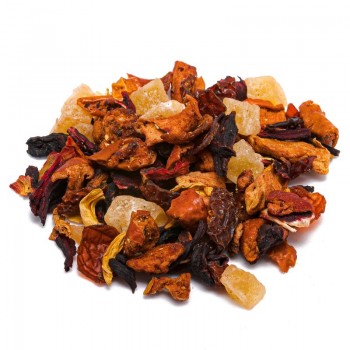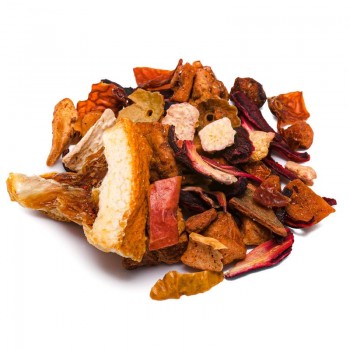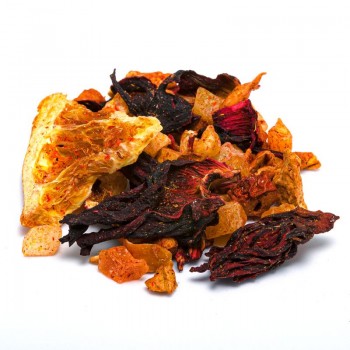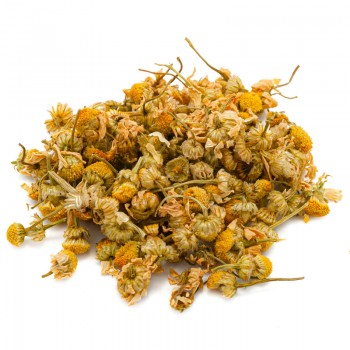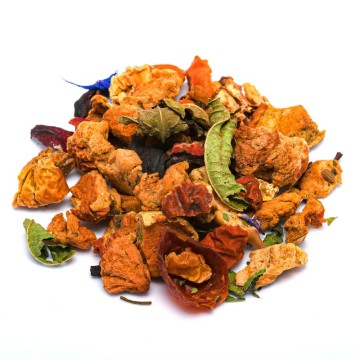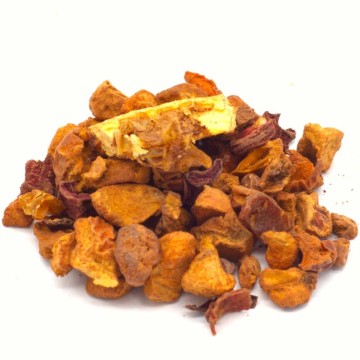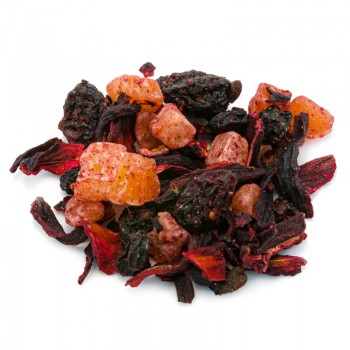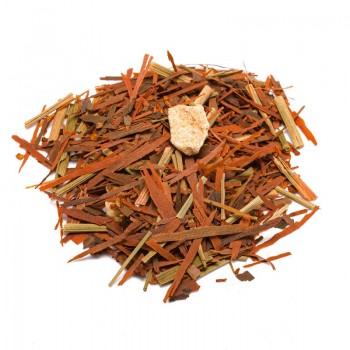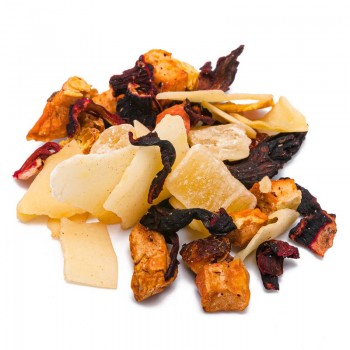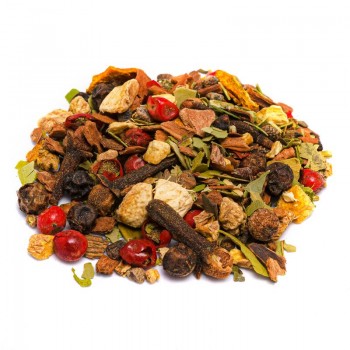Two well-known tropical fruits, typically exotic, are combined with other ingredients in a selected combination in the fruit infusion. The mango flakes and maracuja, passion fruit create a pleasant surprise on the palate! The sweet note of mango gives a fruity, delicious, acidic and fragrant flavour; while maracuja or passion fruit gives a fresh, slightly sour and substantial note. The appetizing flavor nuances of hibiscus, dog rose and elderberries are sweetened and balanced by apple and papaya, for a decidedly harmonious and tasty combination. Among exotic fruit infusions, this combination is a true classic, much appreciated even by the little ones for its sweetness.
Mango and Maracuja infusion: properties and benefits
The blend is based in particular on the virtues of tropical fruits, including mango rich in antioxidants, mineral salts and vitamins. The presence of mango can promote the well-being of the body due to its properties of strengthening the immune system, thanks to vitamins and carotenoids - which stimulate the correct functioning of the immune defenses and protect eyesight.
The supply of vitamin C is also useful for the well-being of the skin, and this substance is also made available in the infusion by elements such as hibiscus petals, dog rose and elderberries. Furthermore, mango contains a specific polyphenol called mangaferin, studied for its natural properties against irritation and inflammation. Mango and papaya, combined in the infusion, can alleviate conditions of digestive difficulty, promoting the assimilation of food and intestinal transit. Papaya, in fact, adds enzymes that aid digestion as well as providing other antioxidants, vitamins and minerals. Beneficial properties after the meal, also enhanced by the apple in the infusion.
Maracuja is another tropical infusion ingredient also known as passion fruit. It contains various minerals and antioxidants, such as flavonoids and phenolic compounds and interesting qualities of alpha and beta carotene – the body uses beta-carotene to produce vitamin A. Beta-carotene from mango also has a positive effect on the mucous membranes, and together with the properties of Elderberries can create a warm infusion useful for soothing the symptoms of colds and nasal congestion.
Origins and history of cultivation
Mango, a tropical fruit with hundreds of varieties, scientifically known as Mangifera indica – is native to India, although it now grows in all tropical and subtropical areas of the world. For centuries the mango has been linked to Hindu culture, where it appears in many legends as a sacred tree. Its leaves were used to create garlands in temples, decorate ritual and wedding banquets.
In the 4th BC. the mango spread to East Asia, then to Africa in the 10th century via Arab merchants and finally to South America via the Portuguese in the early 17th century. It was they who gave the fruit its current name, derived from the Indian Tamil phrase maangai, which in Portuguese became "manga" and then mango. In Europe it is cultivated in Spain (Andalusia) and Sicily, so it is found on our tables seasonally. Passion fruit is a purple or yellow tropical fruit that grows on the vine of some varieties of the Passiflora genus, particularly Passiflora edulis.
In addition to "passion fruit", it has many names, including maracuya in Spanish and maracuja in Portuguese. Versions of the passion fruit plant are yellow or purple, and the larger and more resistant yellow one (maracuja), is the one often used for juice production; purple passion fruit is sweeter and more aromatic.
Fruits and flowers
Mango comes from the evergreen plant Mangifera indica, of the Anacardiaceae family. Native to southern Asia, it has pointed leaves and pinkish-white or yellowish flowers. Not all flowers bear fruit, in fact the mangoes obtained are few compared to the flowers. They usually require three to six months to mature, depending on the variety of Mangifera grown. The fruits are drupes with a yellow to green to red-green skin. They give a tender and yellow pulp; they appear with variable dimensions, even considerable ones. Maracuja is the fruit of the Passiflora edulis Sims plant, of the Passifloraceae family. It is native to South America, and is known in Italian as passion fruit or maracuja.
Among the most important varieties of this pithere are the purple passion fruit (Passiflora edulis f. edulis) and the yellow one (Passiflora edulis f. flavicarpa). All species of the climbing plant produce round flowers and fruits with a thick skin; they contain many seeds enclosed in a sweet pulp (about 250). The Carica papaya is a not very large tree of the Caricaceae family, with little branching. It grows in some up to 10 meters high, better if it is found in a warm or temperate temperature. The flowers grow continuously, even at the same time as the fruits. The color of the fruits can have various shades between green, yellow, orange or pink. Hibiscus flowers are called Hibiscus sabdariffa L. a plant of the Malvaceae family. It is used as an alternative medicine remedy using its useful parts including leaves and shoots, stems, calyxes and seeds. The calyxes and petals of the dried flowers create the hibiscus infusion. The Rose is a perennial plant of the Rosaceae family.
There are over three hundred species and thousands of cultivars, and most species are native to Asia. The Rosa Canina variety generates a fruit called rosehip. Apples derive from the Malus domestica plant of the Rosaceae family. It is a tree native to Asia, now widespread throughout the planet. The fruits can grow with various colors based on the many varieties, and have been used in food for millennia. The European Sambucus nigra plant belongs to the Sambucus genus in the Adoxaceae family. It is a shrub widespread in Europe and western Asia, which grows in humid places such as swamps and marshes. The cream-colored flowers are hermaphroditic and become small purplish-black berries.
Nutritional values of the Mango and Maracuja infusion
The infusion contains several nutrients including minerals, vitamin A, C, group B vitamins, beta-carotene. It also makes several antioxidants available.
How to use the ingredients in the infusion
The infusion is obtained by placing approximately 3-5 grams of the mango and maracuja mixture with water at 100 °C in a cup (250 ml). Leave to infuse for 10 to 12 minutes before drinking. Add honey or sugar, if desired.
Mango and Maracuja infusion: side effects and contraindications
It is necessary to respect the recommended doses and not exceed for too long periods. Excessive intake can cause diarrhea, gastric acidity, headache and nausea.






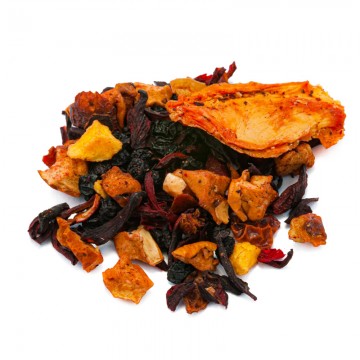




 No reward points for this product.
No reward points for this product.

